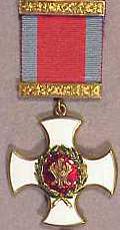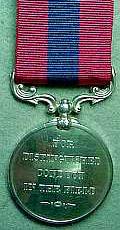Distinguished Service Order
The Distinguished Service Order (DSO) was introduced by Queen Victoria in September 1886, for officers who distinguished themselves in war.

Some DSOs were awarded for acts of bravery, but others were awarded to officers who had led their men well in battle.
The first DSO badges were awarded to officers who had fought in the war in Egypt, and these original crosses were made of enamelled gold. Later, they were changed to enamelled silver.
This gold DSO was awarded to Lieutenant de Lisle ‘for action at Ginnis‘, and was one of the very first awarded.
Distinguished Conduct Medal
The Distinguished Conduct Medal (DCM) was introduced by Queen Victoria as an award for bravery in battle for ‘other ranks‘ (not officers, but sergeants, corporals, privates etc.).

For these ranks, only the Victoria Cross was a higher award for bravery.
The medal is made of silver, the obverse (front) has the Royal Arms in the centre of a trophy of arms (weapons, drums, flags) and the reverse (back) has the inscription ‘For Distinguished Conduct in the Field’.
Sergeant A.M. Stuart received a DCM for his bravery at Ambigole Wells in December 1885. The recommendation submitted to Queen Victoria on 18 November 1886, held at The National Archives [WO146/1, page 75] reads as follows:
Most humbly submitted to Your Majesty by His Royal Highness the Field Marshal Commanding in Chief with the approval of The Secretary of State for War.
That a Silver Medal for Distinguished Conduct in the Field be granted, without Annuity or Gratuity, to each of the under mentioned soldiers in recognition of their gallant conduct during the Soudan Campaign of 1885 – 6.


